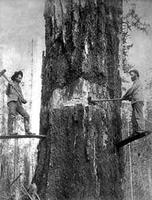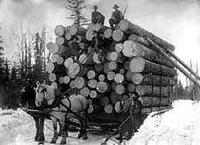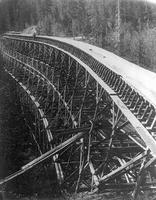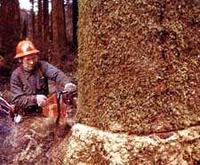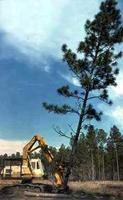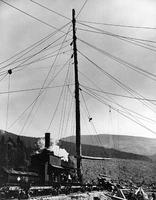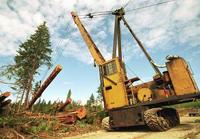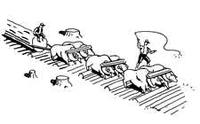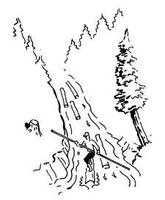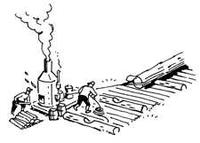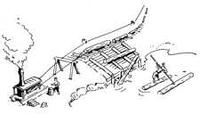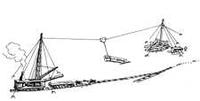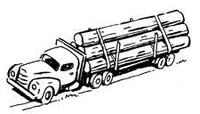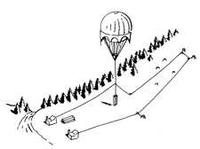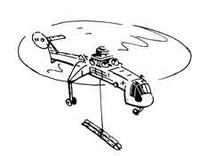Logging
LOGGING, as a distinct branch of the FOREST INDUSTRY, began at the head of ALBERNI INLET in 1860. The work was done under the direction of the head logger, Jeremiah ROGERS, to supply wood to the province's first major SAWMILL. With axes to fell the giant DOUGLAS FIR trees and oxen to skid the logs to the mill, it was a short-lived operation: the accessible timber supply was soon consumed. Within a few years the mill closed and its founder,Capt Edward STAMP relocated with Rogers at HASTINGS MILL on the site of what later became VANCOUVER. The first Interior mill opened in the CARIBOO, near BARKERVILLE, in 1860.
Early Techniques
The earliest west coast loggers discovered that logging methods used in eastern N America were of limited use in the wet coastal rain forests with their enormous trees and soggy ground, and their wild RIVERS that were unsuited to log driving. Coastal BC loggers and their American counterparts in the Pacific Northwest devised entirely new systems and equipment to harvest the valuable timber that would be milled into lumber and exported to the rest of the world.
In the Interior, with its smaller trees and drier, colder CLIMATE, logging techniques were similar to those used in the East. Much of the work was done in the winter. Logs were loaded on sleds pulled by horses, either to nearby BUSH MILLS or to LAKES and rivers on which they were towed to bigger mills. In some locations, such as Adams Lk, long wooden flumes were built to carry logs. These methods prevailed in the Interior until mechanized equipment appeared in the 1920s and 1930s.
The earliest method of moving felled trees was with oxen and horse, along skid trails made of cross-logs. Once the timber within skidding range of the mills was cut, other means had to be devised. The first indigenous form of coastal logging was called HANDLOGGING. Trees along the steep shoreline were felled; with the aid of jacks they were moved into the water, where they were cut into logs and towed to the mills.
Application of Steam Technology
Beginning about 1890 many radical changes in equipment were introduced. In that year crosscut saws were first used to fall and buck trees. In the late 1880s a small steam-powered locomotive known as OLD CURLY, used on construction of the CPR, was put to work logging in SURREY. In 1892 the first steam-powered yarder was acquired by the VICTORIA LUMBER & MANUFACTURING CO in CHEMAINUS. With these innovations trees could be cut much more easily, far inland from the mill and the water. The winch, known as the "donkey," dragged logs to the water or the railway, from where they were hauled to the mill. This form of hauling, or "yarding," was called ground-lead logging, because logs were dragged on the ground or along skid roads. It was the main system used for almost 30 years. In 1909 the Comox Logging Co imported the first of half a dozen Lidgerwood skidders, huge machines designed for logging Louisiana swamps. They had 27-m steel towers mounted on large rail cars and several winches. Similar set-ups using limbed and topped trees or spars, instead of steel towers, later became popular. A heavy skyline ran from the skidder to the top of the spar, and then to the back end of the area being logged, where the trees were already felled and bucked into logs. Another line, the mainline, pulled a carriage hanging from the skyline. The carriage was pulled out over the logs with a haulback line. A set of tongs on the end of the mainline were attached to the log and the winch hauled in the line, lifting the log off the ground in the process. This was known as skyline logging. At about the same time another system, called high-lead logging, was developed. A mainline ran from the winch through a block at the top of a tall spar tree and out to the logs without the use of a skyline. The logs were dragged in over the ground, and could be lifted over obstacles by applying a brake on the haulback line while pulling on the mainline. Cable logging systems were used only rarely in the Interior.
From Railways to Helicopters
In the 1920s, gasoline engines began to replace steam engines on yarders and loading machines. Diesel engines came into use somewhat later. Trucks were used to haul logs in the early 1920s, but because suitable road-building equipment was not available they had to operate on log or plank roads. In the 1930s Caterpillar tractors appeared and were quickly adopted by loggers to skid logs and build roads for trucks. However, until the late 1940s the main means of hauling logs from roadside landings was the steam railway (see RWY LOGGING). During WWII a shortage of skilled fallers contributed to the rapid development of gasoline-powered saws. By the end of the war one of the world's major power saw manufacturers, Industrial Engineering Ltd, was located in Vancouver, producing saws developed by coastal BC loggers.
During the economically buoyant post-war period, several changes were introduced in logging systems. Wooden spar trees were replaced with portable steel spars, complete with their own winches on self-propelled frames, that could be moved to new locations easily and quickly. Bigger and more powerful trucks gradually replaced railways in almost all operations, travelling on roads built with a variety of new road-building machinery. Rubber-tired skidders, equipped with a small winch and capable of travelling over rough, off-road terrain came into widespread use in the Interior and on the coast. They could winch logs short distances, and then drag a turn of several logs over much longer distances than skyline or high-lead systems could yard. After the mid-1960s several new types of machines were introduced. By the late 1990s feller-bunchers were being used extensively in the Interior and to a lesser degree on the coast. The feller-buncher is a large, tracked or wheeled machine with a power saw and a hydraulic clamp on the end of a boom. It falls and stacks trees in piles; these are skidded to the road with rubber-tired skidders equipped with large grapples.
One of the most versatile pieces of equipment introduced has been the hydraulic excavator. As originally designed, it became the primary piece of road-building equipment. When the bucket is replaced with other devices, it can be used for loading logs, tossing them toward the road in a method called "hoe chucking." It can also be used to operate feller-bunchers and tree processors, and for a host of other tasks. On the coast, until the 1990s, the favoured yarding system used grapple yarders. Cables were strung from the yarder, which moved along a road, to a stump or another heavy machine at the back end of the area being logged. A grapple tong was hauled out along the cable and dropped on a log, which it grabbed. Another line hauled the grapple and log to roadside. Later, in order to minimize road building and to avoid environmental damage, skyline yarding systems began replacing grapple yarders. Since 1975 a growing number of heavy-lift helicopters have been used on the coast to haul logs from the woods to landings or drop them into nearby bodies of water (see HELI-LOGGING). Another semi-aerial system uses a large helium-filled balloon to hold up a skyline, along which logs are hauled. In the early 1980s a variety of sophisticated machines began to appear in forests throughout the province to selectively log the relatively small coastal second-growth and Interior forests. These feller-processors and forwarders were manufactured and first used in Europe. They will likely be complemented by many other types of new machines as harvesting of second-growth forests becomes more widespread. By the late 20th century, operations in some parts of BC were using horses once again in selective logging.
Scope of the Modern Industry
In 2004 loggers harvested more than 92 million cubic m of timber—most of it in the Interior. Logging is the most dangerous job in BC: about 40 loggers die each year on the job and many more suffer injury when they are struck by trees or maimed by equipment. Since 1906 there have been restrictions on log exports, and almost all the logs harvested in BC are processed in the province.
In the mid-1970s an enormous and heated controversy arose over the extent of logging in BC and the practices loggers use. As a result, an increasing amount of the forest land base has been protected from logging and regulations restricting the way logging is done have been adopted.
by Ken Drushka
Reading: Ken Drushka, Working in the Woods, 1992; Ken Drushka, Tie-Hackers to Timber Harvesters, 1998; Bus Griffiths, Now You're Logging, 1978.
All illustrations are by Kim LaFave and based on "Bull Cats" by Bert Bushell.

